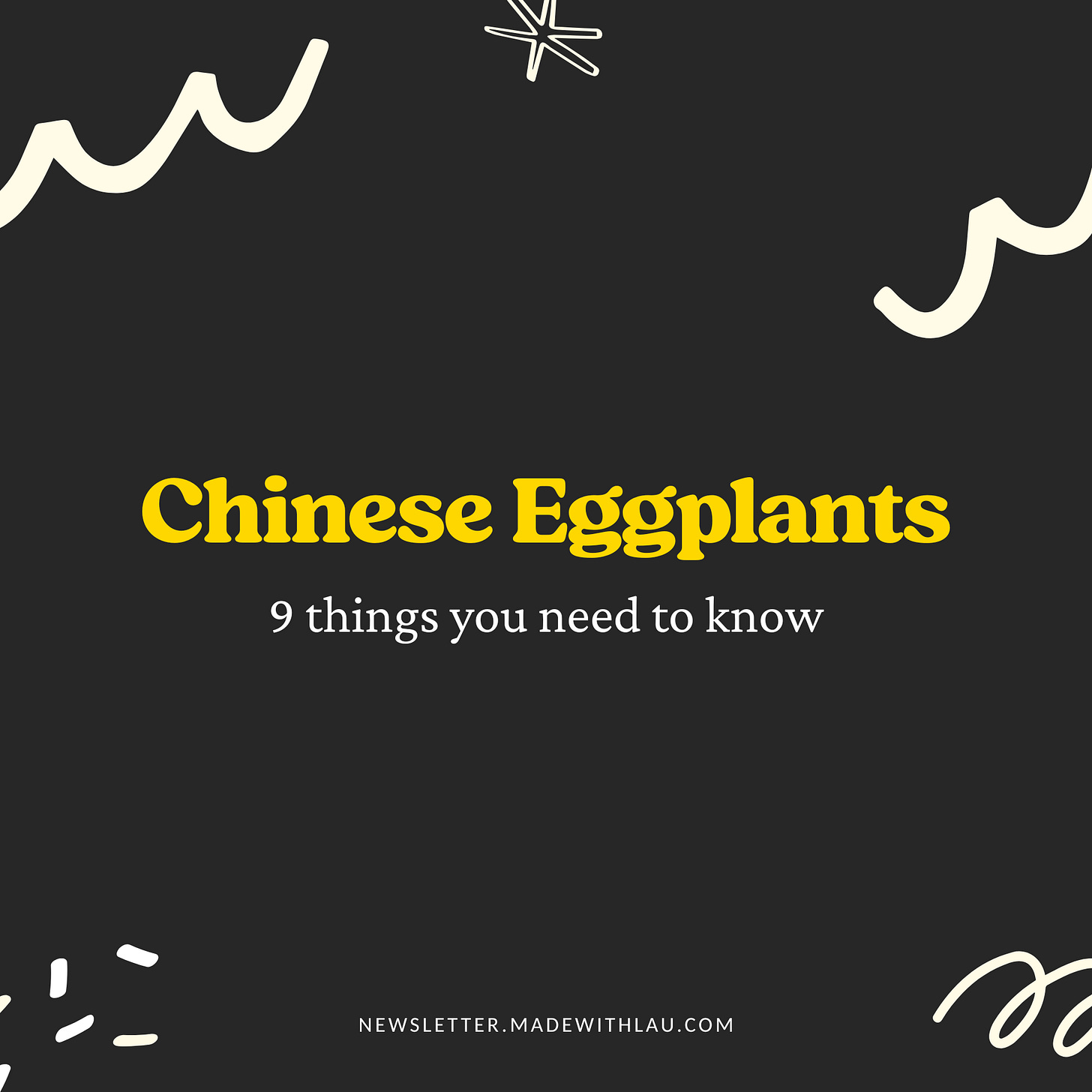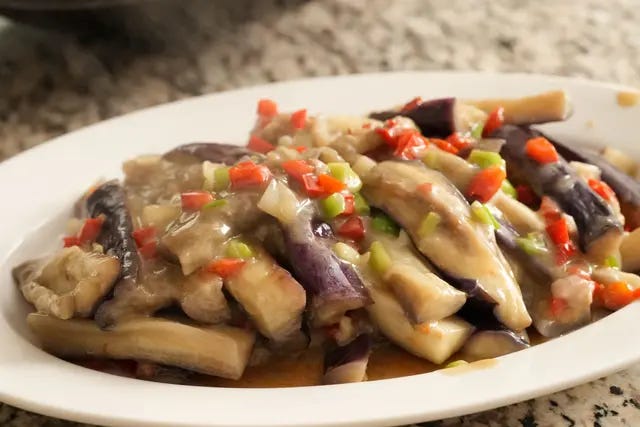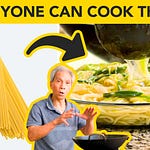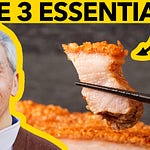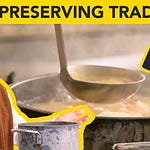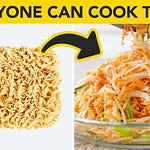Welcome to issue #003 of our Cookbook Chronicles! Each week, I share lessons and wisdom from our cookbook development, preserving my dad’s 50 years of experience as a Chinese chef.
If you want to help shape our efforts in making a timeless Cantonese cookbook, join our community of 400+ members. You’ll get a digital copy once it’s ready, as well as full access to our extra weekly Cookbook Confidential newsletter and our private group chat. Founding Members will also have their name in our cookbook acknowledgements, and a signed physical copy.
But first.. happy birthday Mom and Julian!
Before I get into the actual cookbook stuff… today is my mom’s birthday AND my son Julian’s 1st birthday! (They’re on the same day! How special!)
We’ll be celebrating today in a few hours for dinner + later on the weekend. Woo!
Chinese Eggplant 101
One ambition I have for our cookbook is to help demystify every single ingredient that’s commonly used in Cantonese cooking.
Asian grocery stores often feel quite intimidating, and I just stick to what I know. My parents are able to dance through the aisles, spot deals, rummage for the freshest ingredients.
Furthermore, they know 10 different ways to use every ingredient they buy.
This carefree intuition and wisdom is what I want for all of us.
In that spirit, I present to you…
*drumroll*
Our first ingredient guide:
This post is packed with tips. If you’re viewing from your email inbox, it might get cut off, so click here to read the entire thing.

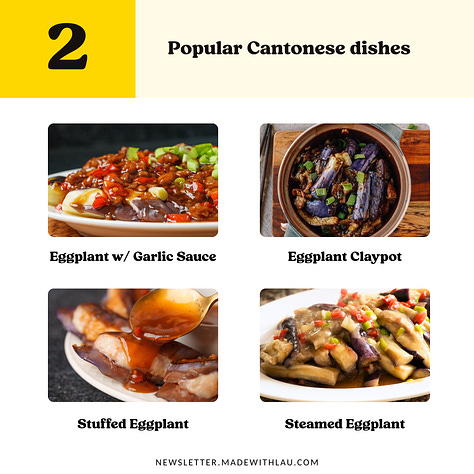







1 - Chinese eggplants are long and thin
The best way to spot a Chinese eggplant is by its shape - they're long and thin like cucumbers.
Also known as ke2 ji2 茄子 or ai2 gwaa1 矮瓜, these are distinctly different from globe eggplants that are more common in Western grocery stores.
(China is also home to many globe-like, bulbous eggplants - my dad used to call these "Beijing eggplants” or “northern eggplants")
2 - Popular dishes
Eggplant with Garlic Sauce
Stuffed Eggplant
Steamed Eggplant
Back in the day.. my dad always used to eat steamed eggplant with fermented bean curd. His mom would halve them and place the eggplants on the edge of a wok that was cooking rice. The eggplants and rice would finish at the same time, and he’d eat them with fermented bean curd or salty shrimp.
3 - Why choose Chinese eggplants?
fewer seeds = less bitter
thinner skin = easier to chew
4 - Buying: Fresh ones should wiggle
brighter, glossy skin
not wrinkly
thin, slender (not thick)
should be easy to bend, not firm
5 - Storing: Keep them separated
Wrap in paper towels, put in a bag with holes, try to keep them separate.
6 - Substitution: Using Western eggplants
For Chinese dishes, if you only have access to globe/Western eggplants, here's what my dad would do:
Remove the core
Peel zebra-like stripes to mitigate the tough bites of thick skin while maintaining structural integrity.
If you peel everything, the eggplant will be too soft. If you don't peel anything at all, skin is too thick.
7 - Prep: 3 main types of cuts
Strips - what my dad does most often with eggplant
Cut out equal sized sections
Cut those sections in half
Cut the halves along the radius, 3 or 4 times
Rolling oblique cut
My dad didn’t do a ton of these in the video but you basically cut at a diagonal, roll the eggplant a little bit, repeat, so you get these little oblong shapes.
We cover the oblique cut a lot more in one of our mini masterclasses on knife skills: https://madewithlau.com/club/courses/3
With eggplants, this type of cut is great if you’re deep frying or braising.
Envelopes
This is more specifically for stuffed eggplants, but basically you cut diagonal slices, alternating between slicing all the way through and slicing just 75% of the way down, which creates a little pocket you can stuff things in.
8 - Prep: Soak and squeeze
There are two main tasks here:
Soaking in water, salt and vinegar for 10 to 15 minutes
This helps expel the brown/darker fluids, similar to how an apple gets darker when you leave it out.
My dad doesn’t always soak them but he highly recommends it for Western eggplants
Add enough water to submerge everything. Add 2 tbsp rice vinegar + 1 tbsp salt. Rice vinegar + salt help expel the brown/darker fluids, similar to how an apple gets darker when you leave it out.
Soak the slices for 10-15 minutes, placing a dish on top to force the eggplants downwards.
Squeezing - eggplants are a lot like sponges and squeezing each eggplant kinda empties the sponges and allows for future flavors to be absorbed
9 - Cook: Two stages of cooking
Goal #1 - soften the eggplant
Goal #2 - add flavor, topping, and/or texture
The Recipes
Our video pulls from a few of our existing Chinese Eggplant recipes. If you want to recreate them…
3 of these recipes are already live on our blog!
Chinese Eggplant with Garlic Sauce: https://madewithlau.com/recipes/eggplant-with-garlic-sauce
Stuffed Eggplant: https://madewithlau.com/recipes/chinese-stuffed-eggplant
Western Eggplant with Garlic Sauce: https://madewithlau.com/recipes/steamed-chinese-eggplant
There’s another recipe we haven’t yet published
For our Chinese Eggplant cookbook shoot, my dad recreated a version of his mother’s dish: Microwaved Eggplant with Fermented Bean Curd.
IT WAS SO GOOD. (And very special to get a taste of his childhood.)
For now, we have to keep this recipe private — just for paid subscribers, as this recipe may go into our cookbook.
Microwaved Eggplant with Fermented Bean Curd
Dad: My mother always used to make eggplants with fermented bean curd for us growing up. This is simple introduction to cooking with Chinese eggplants, with a wok-free "simple" mode if you're busy and a "traditional" mode with more colors and aromas.
Ingredients
Listen to this episode with a 7-day free trial
Subscribe to Made With Lau to listen to this post and get 7 days of free access to the full post archives.


